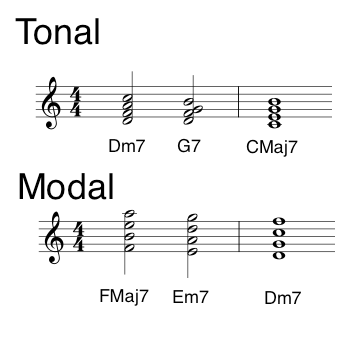Introduction
The vast majority of music written in the last few centuries has been ‘tonal’. This is the type of music we are all used to hearing day to day. However, in the 1950’s Jazz musicians began feeling restricted by ‘tonality’ and started experimenting with other ways of structuring harmony (i.e. chords).
From Tonality (which encompasses your more traditional Jazz all the way through to Bebop, Hard-bop and Cool Jazz) Jazz musicians moved to Modality (Modal Jazz) and Atonality (Free Jazz – though Free Jazz is NOT necessarily atonal).
In this lesson we’re going to start with the difference between Tonal Harmony vs Modal Harmony.
Just as a semantic aside, when I say ‘modal harmony’ I am referring to the modern meaning of the term – that is Miles Davis/Kind of Blue/Modal Jazz Modal Harmony – and NOT Medieval music or Gregorian Modes.
Modality
Modality has the following features:
- It uses all modes (Ionian, Dorian, Phrygian, etc.)
- It does NOT use a Functional Harmony
- It has a Tonal Centre (i.e. root note)
Modal songs can be written in any mode (not just major and minor), so for example it can be in the key of D Dorian.
In Modal Harmony, chords DO NOT have a function, so in a sense: all chords are equal. A chord DOES NOT need to resolve to any other chord. But there is still a Tonal Centre – for example the note D in the key of D Dorian (i.e. the root note).
But because there is no ‘functional harmony’ the chords DO NOT feel like they need to resolve to the tonic or Dm7 chord. Each chord just floats there by itself as a standalone entity.
In order to achieve this you have to avoid playing the diatonic tritone – because this tritone interval creates a dissonance which sounds like a Dominant Chord and feels like it wants to resolve to the Tonic Chord, thus turning the music tonal.
So it’s a delicate balance. You have to make D sound like the ‘tonal centre’ but you can’t do it by using the function of the diatonic chords. So you:
- CAN’T use a dominant chord to establish the tonic (i.e. A7 to Dm)
- CAN use Pedal point (Repeat Root Note)
- CAN use Ostinato (Repetitive pattern)
Because the majority of music we hear (pop, rock, etc) is tonal and chords are usually built out of stacked 3rds, we’ve learned to associate chords built in thirds with tonal harmony. The way to get around this problem is to build chord with 4ths – that is, use Quartal Chords. By building chords in 4ths, you break that tonal anticipation of the Dominant chord wanting to move to the tonic and you create a more ambiguous, vague and modal sound.
Because modal chords don’t have ‘functions’, they don’t have to go anywhere (i.e. they don’t have to resolve to the tonic). They just float around. So modal songs usually don’t have chord progressions. They just state the key/scale/mode the song is in and it’s your job to play any diatonic chords (i.e. Dm7, Em7, FMaj7, G7, Am7, Bø7, & CMaj7 in the key of D Dorian) and make your own ‘chord progression’.
So then when playing a Modal Song you have to:
- Emphasis the root note in the bass (to reinforce the tonal centre); and
- Avoid playing the diatonic tritone (to avoid tonal sound)
- DO NOT play Bø7
- Play G Triad (instead of G7) to avoid the tritone interval
- Move around the diatonic chords at random but smoothly (generally stepwise)
- Keep the chord movements sparse and simple – not too busy, not too many chords, nice and boring. The chords are there just to create a harmonic underlay.
- Use Quartal Chords (to avoid tonal sound)
Modal harmony creates a more ambiguous and vague sound and is now considered much more ‘modern’ than traditional tonal harmony. Modal Harmony completely changed the way people think about Jazz and improvisation. It gave the soloist greater freedom and choice in his or her solo (I’ll have much more to say about this in the next lesson).
Tonal Harmony vs Modal Harmony Summary
And that, in a nutshell, is the difference between Tonal Harmony vs Modal Harmony. So, in summary:
| Tonality | Modality |
|---|---|
| Uses Major & minor keys | Uses all modes |
| Functional Harmony | No Functional Harmony |
| Tonal Centre (root note) | Tonal Centre |

Have a Listen to
- So What ~ Miles Davis
- Milestones ~ Miles Davis
- My Favorite Things ~ John Coltrane
- Impressions ~ John Coltrane
- Little Sunflower ~ Freddie Hubbard
- Footprints ~ Wayne Shorter
